Protected Area Monitoring in the Niger Delta Using Multi-Temporal Remote Sensing
Abstract
:1. Introduction
2. Materials and Methods
2.1. Study Areas
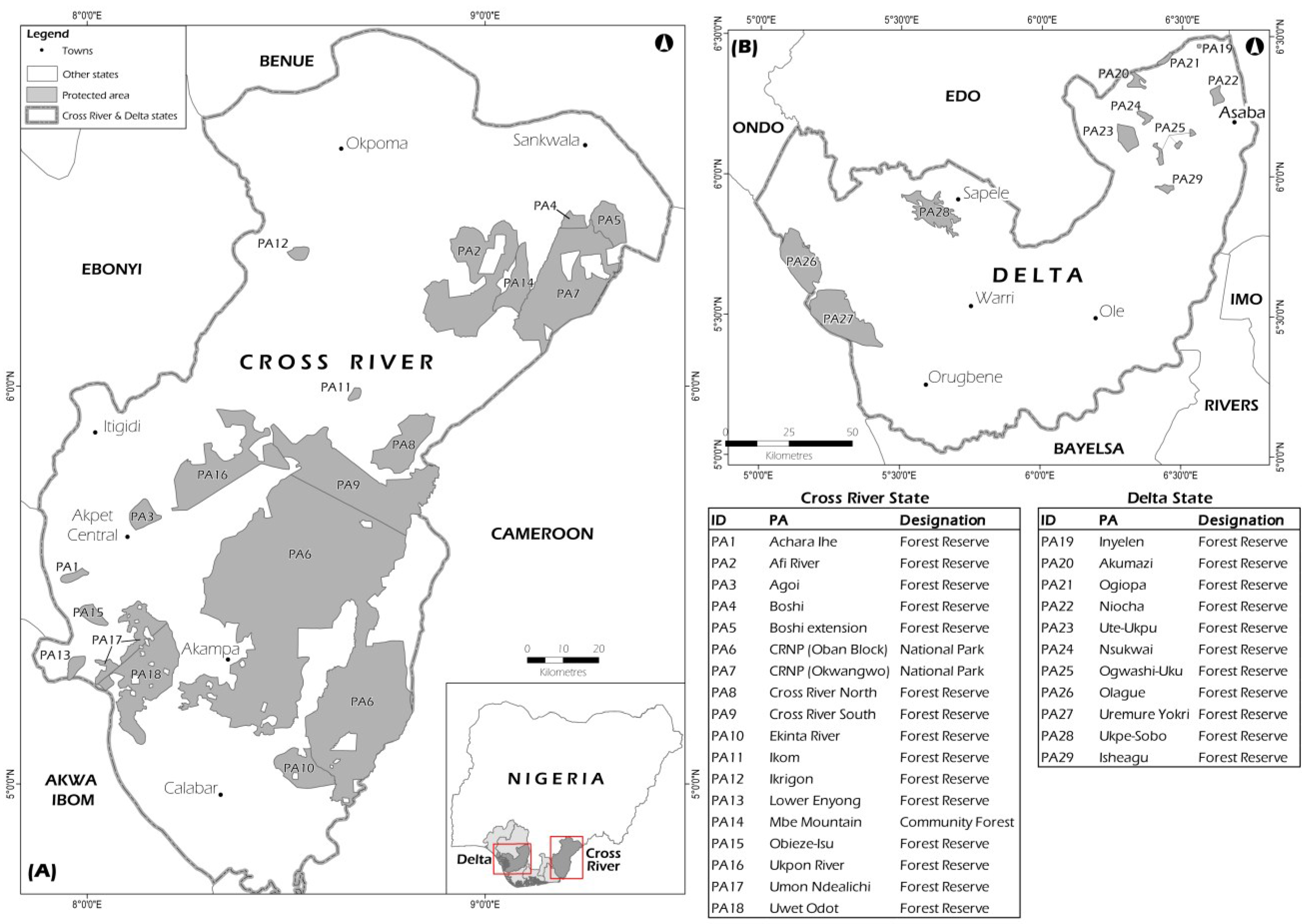
2.2. Remote Sensing Analysis
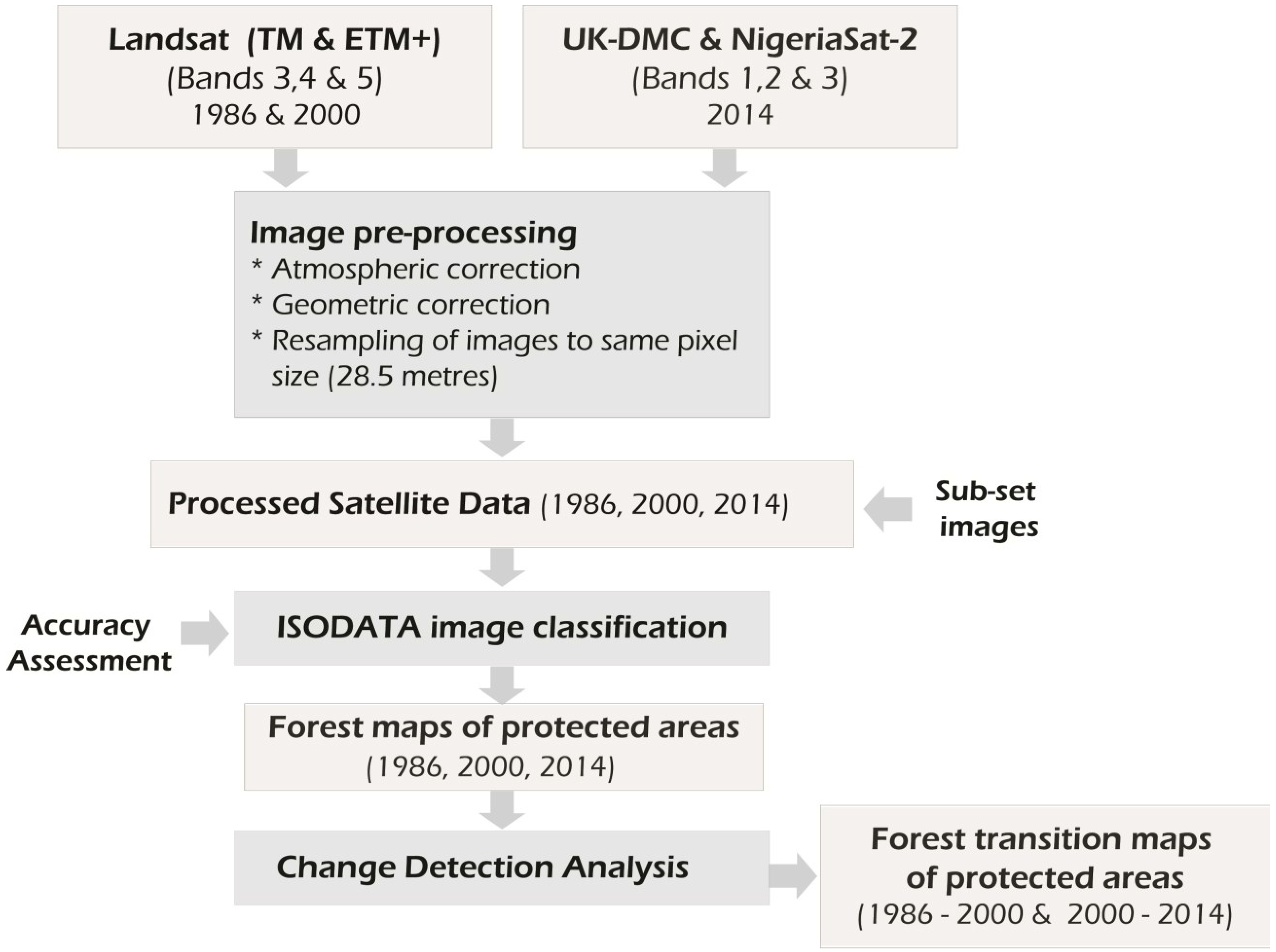
| State | Platform/Sensor | Spectral Resolution | Date of Acquisition | Path | Row | Spatial Resolution (m) |
|---|---|---|---|---|---|---|
| Cross River State | Landsat-5 TM (bands 3–5) | B3: 0.52–0.60 µm (Green) B4: 0.63–0.69 µm (Red) B5: 0.76–0.90 µm (NIR) | 12 December 1986 | 187 | 55 | 28.5 |
| 12 December 1986 | 187 | 56 | 28.5 | |||
| 12 December 1986 | 187 | 57 | 28.5 | |||
| 19 December 1986 | 188 | 55 | 28.5 | |||
| 19 December 1986 | 188 | 56 | 28.5 | |||
| 19 December 1986 | 188 | 57 | 28.5 | |||
| Landsat-7 ETM+ (bands 3–5) | B3: 0.52–0.60 µm (Green) B4: 0.63–0.69 µm (Red) B5: 0.77–0.90 µm (NIR) | 27 January 2001 | 187 | 55 | 28.5 | |
| 10 December 2000 | 187 | 56 | 28.5 | |||
| 10 December 2000 | 187 | 57 | 28.5 | |||
| 17 December 2000 | 188 | 55 | 28.5 | |||
| 17 December 2000 | 188 | 56 | 28.5 | |||
| 17 December 2000 | 188 | 57 | 28.5 | |||
| UK-DMC-2 (bands 1–3) | B1: 0.52–0.62 µm (Green) B2: 0.63–0.69 µm (Red) B3: 0.76–0.90 µm (NIR) | 7 January 2014 | N/A | N/A | 22 | |
| Delta State | Landsat-5 TM (bands 3–5) | B3: 0.52–0.60 µm (Green) B4: 0.63–0.69 µm (Red) B5: 0.76–0.90 µm (NIR) | 21 December 1987 | 189 | 56 | 28.5 |
| 15 January 1986 | 190 | 56 | 28.5 | |||
| Landsat-7 ETM+ (bands 3–5) | B3: 0.52–0.60 µm (Green) B4: 0.63–0.69 µm (Red) B5: 0.77–0.90 µm (NIR) | 28 January 2002 | 189 | 56 | 28.5 | |
| 17 February 2001 | 190 | 56 | 28.5 | |||
| NigeriaSat2 (bands 1–3) | B1: 0.52–0.62 µm (Green) B2: 0.63–0.69 µm (Red) B3: 0.76–0.90 µm (NIR) | 18 January 2014 | N/A | N/A | 22 |
2.2.1. Image Classification and Accuracy Assessment
2.2.2. Forest Cover Change Analysis
2.2.3. Forest Fragmentation Analysis
3. Results and Discussion
3.1. Forest Classification Accuracy Assessment
| Forest Map—1986 | ||||
| Classified Data | Forest | Non Forest | Row Total | Users Accuracy (%) |
| Forest | 370 | 69 | 439 | 84.3 |
| Non Forest | 31 | 160 | 191 | 83.8 |
| Column Total | 401 | 229 | 630 | |
| Producer’s Accuracy (%) | 92.3 | 70.0 | ||
| Overall Accuracy (%) | 83.1 | |||
| Forest Map—2000 | ||||
| Classified Data | Forest | Non Forest | Row Total | Users Accuracy (%) |
| Forest | 298 | 83 | 381 | 78.2 |
| Non Forest | 3 | 321 | 324 | 99.1 |
| Column Total | 301 | 404 | 705 | |
| Producer’s Accuracy (%) | 99.0 | 79.5 | ||
| Overall Accuracy (%) | 87.8 | |||
| Forest Map—2014 | ||||
| Classified Data | Forest | Non Forest | Row Total | Users Accuracy (%) |
| Forest | 155 | 44 | 199 | 77.9 |
| Non Forest | 44 | 242 | 286 | 84.6 |
| Column Total | 199 | 286 | 485 | |
| Producer’s Accuracy (%) | 77.9 | 84.6 | ||
| Overall Accuracy (%) | 81.9 | |||
| Forest Map—1986 | ||||
| Classified Data | Forest | Non Forest | Row Total | Users Accuracy (%) |
| Forest | 118 | 27 | 145 | 81.4 |
| Non Forest | 4 | 183 | 187 | 97.9 |
| Column Total | 122 | 210 | 332 | |
| Producer’s Accuracy (%) | 96.7 | 87.1 | ||
| Overall Accuracy (%) | 90.7 | |||
| Forest Map—2000 | ||||
| Classified Data | Forest | Non Forest | Row Total | Users Accuracy (%) |
| Forest | 126 | 26 | 152 | 82.9 |
| Non Forest | 8 | 160 | 168 | 95.2 |
| Column Total | 134 | 186 | 320 | |
| Producer’s Accuracy (%) | 94.0 | 86.0 | ||
| Overall Accuracy (%) | 89.4 | |||
| Forest Map—2014 | ||||
| Classified Data | Forest | Non Forest | Row Total | Users Accuracy (%) |
| Forest | 81 | 6 | 87 | 93.1 |
| Non Forest | 16 | 137 | 153 | 89.5 |
| Column Total | 97 | 143 | 240 | |
| Producer’s Accuracy (%) | 83.5 | 95.8 | ||
| Overall Accuracy (%) | 90.8 | |||
3.2. Forest Cover Transition and Rates of Change
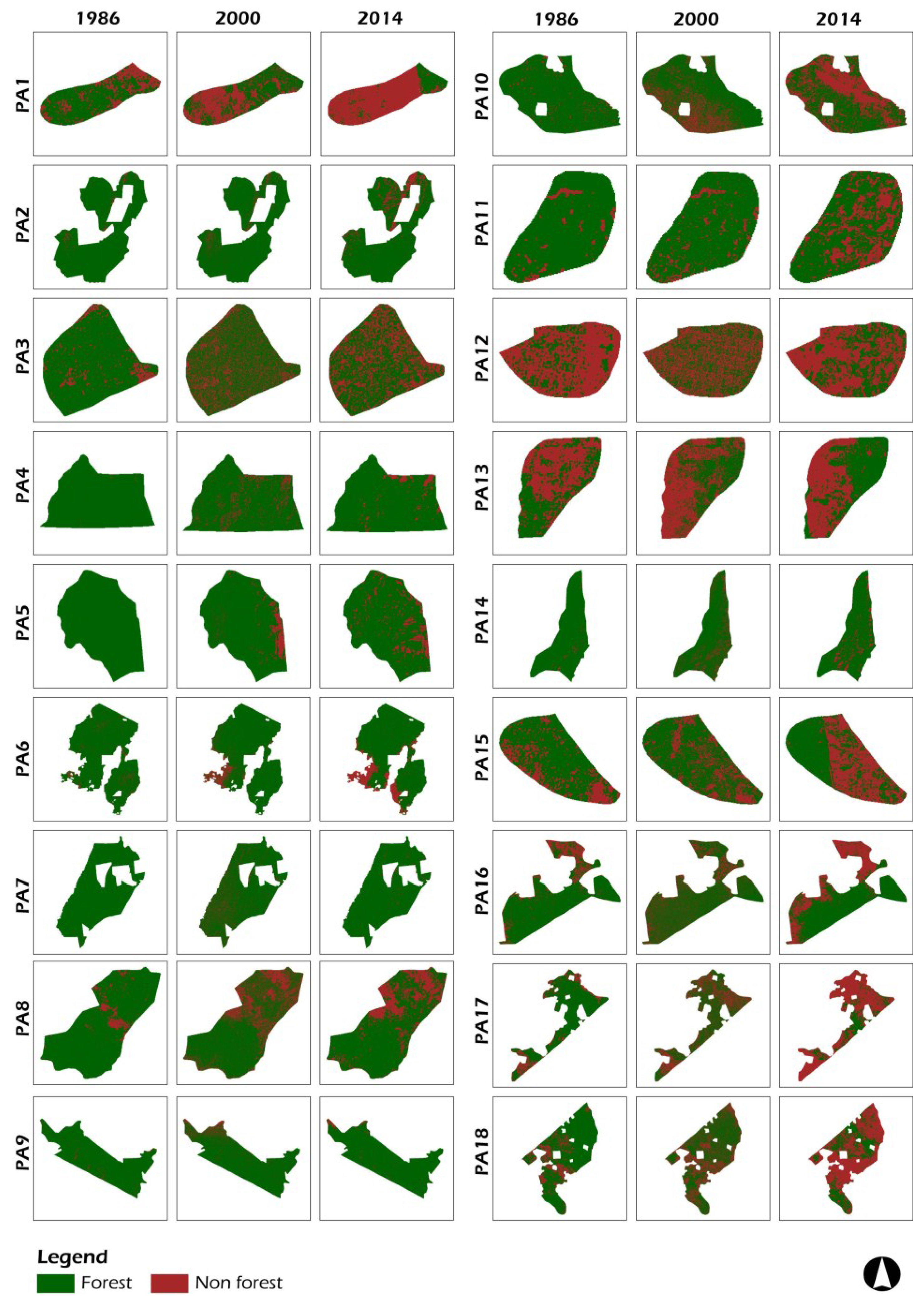
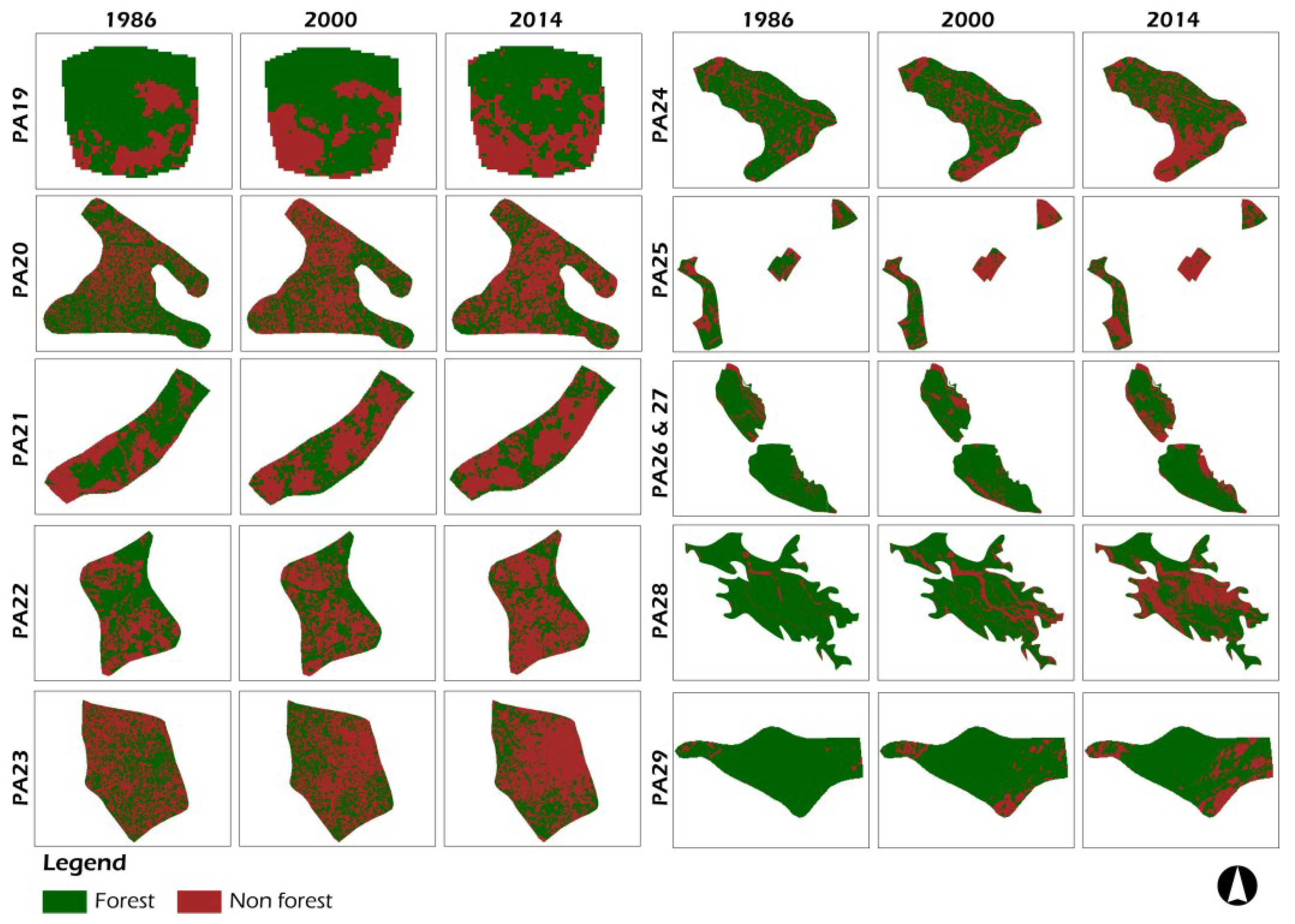
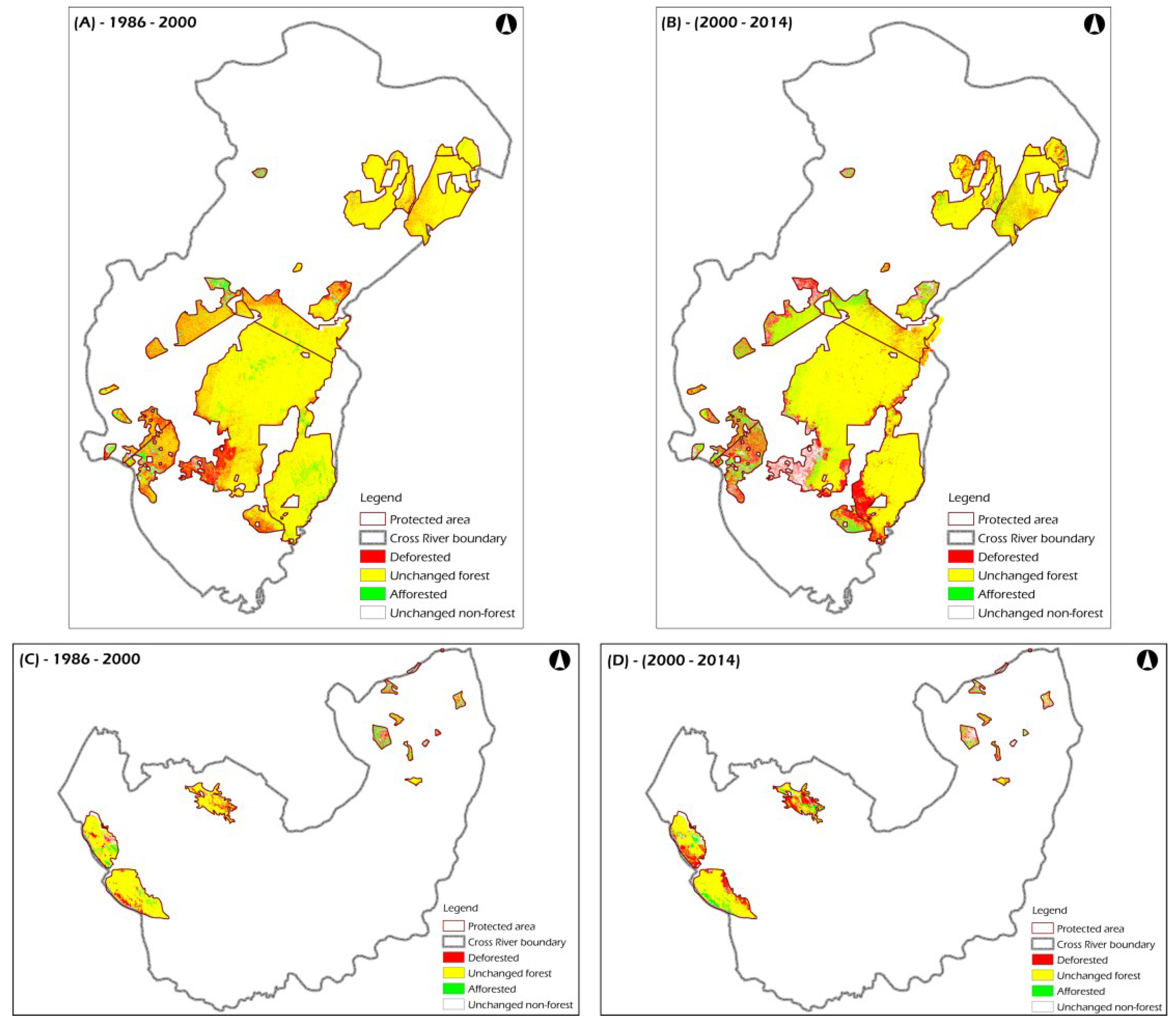
| Site Code | Protected Area | Forest Area (ha) | Deforested (ha) | Ann. Deforestation Rate (%) | Afforested (ha) | Ann. Afforestation Rate (%) | ||||||
|---|---|---|---|---|---|---|---|---|---|---|---|---|
| 1986 | 2000 | 2014 | 1986–2000 | 2000–2014 | 1986–2000 | 2000–2014 | 1986–2000 | 2000–2014 | 1986–2000 | 2000–2014 | ||
| PA1 | Achara Ihe | 1309.4 | 1206.2 | 924.8 | 253.9 | 450.63 | 0.99 | 2.90 | 139.6 | 180.99 | 0.64 | 1.50 |
| PA2 | Afi River | 39,606.5 | 38,602.4 | 35,610 | 1297.9 | 4133.8 | 0.19 | 0.63 | 293.9 | 1141.4 | 0.10 | 0.35 |
| PA3 | Agoi | 3899.4 | 2761.8 | 2513.3 | 1390.7 | 1181.7 | 3.24 | 2.26 | 249.2 | 935.4 | 1.36 | 1.74 |
| PA4 | Boshi | 2479.1 | 2440.7 | 2351.9 | 39.2 | 121.1 | 0.10 | 0.28 | 2.9 | 37.89 | 0.05 | 0.17 |
| PA5 | Boshi Extension | 7136.3 | 7330.9 | 6452.9 | 121.1 | 1415.8 | 0.03 | 1.16 | 315.7 | 537.8 | 0.05 | 0.67 |
| PA6 | CRNP (Oban Block) | 286,099 | 273,160 | 252,709 | 22,572.9 | 28,184.5 | 0.41 | 0.61 | 9658.1 | 7752.0 | 0.26 | 0.34 |
| PA7 | CRNP (Okwangwo) | 51,429.9 | 44,274.1 | 43,259.7 | 25,591.8 | 3601.2 | 3.14 | 0.34 | 198.7 | 2192.94 | 0.48 | 0.23 |
| PA8 | Cross River North | 13,484.5 | 10,112.9 | 10,621.3 | 3783 | 1631.6 | 2.35 | 0.37 | 419 | 2145.5 | 1.02 | 0.55 |
| PA9 | Cross River South | 48,703.9 | 45,369.9 | 43,771.1 | 4250.8 | 5497.4 | 0.53 | 0.53 | 848 | 3754.9 | 0.28 | 0.39 |
| PA10 | Ekinta River | 10,569.5 | 8063.7 | 5622.2 | 2945.6 | 4347 | 2.25 | 5.72 | 437 | 1917.8 | 1.01 | 2.41 |
| PA11 | Ikom | 801.7 | 746.6 | 573.2 | 59.1 | 255.7 | 0.48 | 2.65 | 18.2 | 73.0 | 0.30 | 1.24 |
| PA12 | Ikrigon | 574.3 | 685.3 | 600.1 | 414.7 | 427.6 | 2.33 | 4.28 | 536.6 | 335.2 | 4.19 | 2.95 |
| PA13 | Lower Enyong | 878.8 | 772 | 952.2 | 527.6 | 253.3 | 3.97 | 0.31 | 422.6 | 430.7 | 2.86 | 1.22 |
| PA14 | Mbe Mountain | 8973.3 | 7755.4 | 8144.8 | 1291.4 | 677.7 | 1.02 | 0.12 | 87.8 | 1047.1 | 0.49 | 0.27 |
| PA15 | Obieze-Isu | 1848.6 | 1745.8 | 1789.7 | 531.2 | 796.1 | 1.30 | 1.75 | 432.3 | 404.1 | 1.06 | 0.72 |
| PA16 | Ukpon River | 25,866.5 | 22,425.6 | 20,621.5 | 6746.0 | 6531 | 1.55 | 1.44 | 3322.4 | 4728.2 | 0.94 | 1.07 |
| PA17 | Umon Ndealichi | 8378.6 | 8867.3 | 10,393.2 | 3487.1 | 2843.7 | 1.37 | 0.50 | 791.6 | 2395.7 | 0.11 | 0.32 |
| PA18 | Uwet Odot | 23,632 | 17,688.9 | 22,773.2 | 8389.5 | 10,882.4 | 2.89 | 1.23 | 2458.8 | 4578.6 | 1.36 | 0.09 |
| Total | 535,671.2 | 494,009.5 | 469,684 | 83,693.4 | 73,232.1 | 0.83 | 0.68 | 20,632.1 | 34,589.1 | 0.36 | 0.37 | |
| Site Code | Protected Area | Forest Area (ha) | Deforested (ha) | Ann. Deforestation Rate (%) | Afforested (ha) | Ann. Afforestation Rate (%) | ||||||
|---|---|---|---|---|---|---|---|---|---|---|---|---|
| 1986 | 2000 | 2014 | 1986–2000 | 2000–2014 | 1986–2000 | 2000–2014 | 1986–2000 | 2000–2014 | 1986–2000 | 2000–2014 | ||
| PA19 | Inyelen | 150.8 | 131.1 | 120.2 | 42.3 | 28.4 | 1.53 | 1.29 | 22.7 | 17.7 | 0.95 | 0.89 |
| PA20 | Akumazi | 1334.6 | 1047 | 980.7 | 686.6 | 551.6 | 3.79 | 3.23 | 399.0 | 485.4 | 2.09 | 2.71 |
| PA21 | Ogiopa | 624.5 | 459.2 | 418.5 | 320.1 | 222.7 | 4.35 | 3.08 | 155.8 | 180.5 | 2.09 | 2.38 |
| PA22 | Niocha | 1395.5 | 1188.4 | 843.1 | 576.4 | 610.7 | 2.39 | 5.91 | 283.1 | 133.3 | 1.25 | 1.86 |
| PA23 | Ute-Ukpu | 2612.2 | 2487.7 | 1888.5 | 1754.6 | 1410.8 | 3.68 | 5.97 | 1630.2 | 811.6 | 3.23 | 3.03 |
| PA24 | Nsukwai | 1150.1 | 977 | 737.5 | 365.8 | 478.1 | 1.83 | 4.80 | 369.2 | 161.7 | 1.85 | 1.91 |
| PA25 | Ogwashi-Uku | 1381.5 | 1054.3 | 936.6 | 655.1 | 505.3 | 3.59 | 3.23 | 327.9 | 379.7 | 1.86 | 2.31 |
| PA26 | Olague | 18,442.5 | 18,311 | 14,903.8 | 2067.5 | 5156.2 | 0.37 | 2.28 | 1935.9 | 1749.1 | 0.34 | 1.20 |
| PA27 | Uremure Yokri | 30,964.7 | 29,003.1 | 27,476.1 | 2977.1 | 4186.8 | 0.50 | 0.79 | 1003.1 | 2659.8 | 0.29 | 0.56 |
| PA28 | Ukpe-Sobo | 15,204.2 | 12,567.6 | 9407.1 | 2656.7 | 5210.7 | 1.24 | 3.97 | 20.2 | 2050.2 | 0.56 | 1.94 |
| PA29 | Isheagu | 1370.8 | 1243.4 | 1111.5 | 151 | 195.3 | 0.66 | 1.11 | 23.6 | 63.5 | 0.34 | 0.62 |
| Total | 535,671.2 | 68,469.7 | 58,823.6 | 12,253.2 | 18,556.6 | 0.82 | 1.92 | 6170.4 | 8692.5 | 0.52 | 1.13 | |

3.3. Changes in Forest Landscape Structure
| Metrics | Cross River | Delta | |||||
|---|---|---|---|---|---|---|---|
| 1986 | 2000 | 2014 | 1986 | 2000 | 2014 | ||
| Percentage of forest landscape (%) | 94.3 | 87.8 | 80.5 | 83.1 | 75.7 | 63.5 | |
| Number of patches | 2985 | 13,694 | 11,036 | 1394 | 1832 | 3706 | |
| Effective Mesh Size (× 1000 ha) | 250 | 223 | 182 | 15 | 13 | 10 | |
| Edge Density (m / ha) | 19 | 76.4 | 46.7 | 39 | 40 | 52 | |
| Mean Patch Area (ha) | 179.3 | 35.6 | 41.7 | 53.72 | 37.24 | 15.46 | |
| Mean Shape Index (MSI) | 1.28 | 1.30 | 1.29 | 1.38 | 1.31 | 1.29 | |
| Mean Core Area Index (%) | 169.9 | 28.9 | 36.5 | 48.1 | 30 | 13 | |
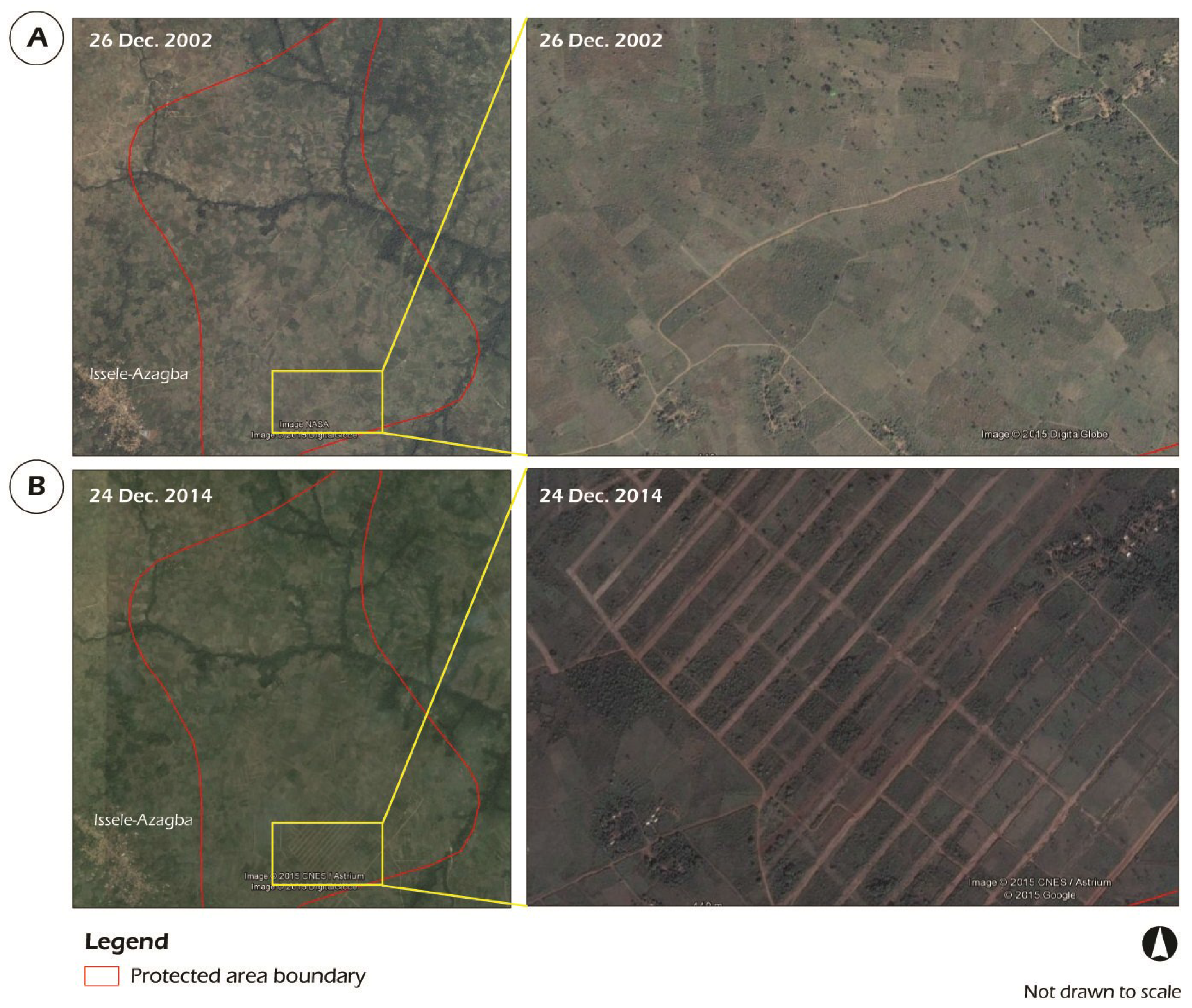
4. Conclusions
Acknowledgments
Author Contributions
Conflicts of Interest
References
- World Bank. Defining an Environmental Development Strategy for the Niger Delta; World Bank: Washington, DC, USA, 1995. [Google Scholar]
- NDES. Niger Delta Environmental Survey Phase 1 Report: Volume I—Environmental and Socio-Economic Characteristics; Environmental Resources Managers Limited: Lagos, Nigeria, 1997. [Google Scholar]
- Kinako, P.D. Conserving the mangrove forest of the Niger Delta. Biol. Conserv. 1977, 11, 35–39. [Google Scholar] [CrossRef]
- Onojeghuo, A.O.; Blackburn, G.A. Forest transition in an ecologically important region: Patterns and causes for landscape dynamics in the Niger Delta. Ecol. Indic. 2011, 11, 1437–1446. [Google Scholar] [CrossRef]
- Amelung, T.; Diehl, M. Deforestation of Tropical Rain Forests. Economic Causes and Impact on Development; J.C.B. Mohr Publisher: Tübingen, Germany, 1992. [Google Scholar]
- Scheffer, M.; Carpenter, S.; Foley, J.A.; Folke, C.; Walker, B. Catastrophic shifts in ecosystems. Nature 2001, 413, 591–596. [Google Scholar] [CrossRef] [PubMed]
- Alongi, D.M. Present state and future of the world’s mangrove forests. Environ. Conserv. 2002, 29, 331–349. [Google Scholar] [CrossRef]
- Vitousek, P.M.; Mooney, H.A.; Lubchenco, J.; Melillo, J.M. Human domination of earth’s ecosystems. Science 1997, 277, 494–499. [Google Scholar] [CrossRef]
- Foley, J.A.; DeFries, R.; Asner, G.P.; Barford, C.; Bonan, G.; Carpenter, S.R.; Chapin, F.S.; Coe, M.T.; Daily, G.C.; Gibbs, H.K. Global consequences of land use. Science 2005, 309, 570–574. [Google Scholar] [CrossRef] [PubMed]
- Andam, K.S.; Ferraro, P.J.; Pfaff, A.; Sanchez-Azofeifa, G.A.; Robalino, J.A. Measuring the effectiveness of protected area networks in reducing deforestation. Proc. Natl. Acad. Sci. U. S. A. 2008, 105, 16089–16094. [Google Scholar] [CrossRef] [PubMed]
- IUCN. Guidelines for Applying Protected Area Management Categories; IUCN: Fontainebleau, France, 2008. [Google Scholar]
- Elias, M.; Hensel, O.; Richter, U.; Hülsebusch, C.; Kaufmann, B.; Wasonga, O. Land conversion dynamics in the Borana rangelands of Southern Ethiopia: An integrated assessment using remote sensing techniques and field survey data. Environments 2015, 2, 1–31. [Google Scholar] [CrossRef]
- Mondal, M.S.; Sharma, N.; Kappas, M.; Garg, P. Critical assessment of land use land cover dynamics using multi-temporal satellite images. Environments 2015, 2, 61–90. [Google Scholar] [CrossRef]
- Borrelli, P.; Modugno, S.; Panagos, P.; Marchetti, M.; Schütt, B.; Montanarella, L. Detection of harvested forest areas in Italy using Landsat imagery. Appl. Geogr. 2014, 48, 102–111. [Google Scholar] [CrossRef]
- Hansen, M.C.; Potapov, P.V.; Moore, R.; Hancher, M.; Turubanova, S.; Tyukavina, A.; Thau, D.; Stehman, S.; Goetz, S.; Loveland, T. High-resolution global maps of 21st-century forest cover change. Science 2013, 342, 850–853. [Google Scholar] [CrossRef] [PubMed]
- Curran, L.M.; Trigg, S.N.; McDonald, A.K.; Astiani, D.; Hardiono, Y.; Siregar, P.; Caniago, I.; Kasischke, E. Lowland forest loss in protected areas of Indonesian Borneo. Science 2004, 303, 1000–1003. [Google Scholar] [CrossRef] [PubMed]
- Giriraj, A.; Babar, S.; Reddy, C.S. Monitoring of forest cover change in Pranahita Wildlife Sanctuary, Andhra Pradesh, India using remote sensing and GIS. J. Environ. Sci. Technol. 2008, 1, 73–79. [Google Scholar]
- Htun, N.Z.; Mizoue, N.; Kajisa, T.; Yoshida, S. Deforestation and forest degradation as measures of Popa Mountain Park (Myanmar) effectiveness. Environ. Conserv. 2009, 36, 218–224. [Google Scholar] [CrossRef]
- Liu, J.; Linderman, M.; Ouyang, Z.; An, L.; Yang, J.; Zhang, H. Ecological degradation in protected areas: The case of Wolong Nature Reserve for giant pandas. Science 2001, 292, 98–101. [Google Scholar] [CrossRef] [PubMed]
- Kouki, J.; Löfman, S.; Martikainen, P.; Rouvinen, S.; Uotila, A. Forest fragmentation in Fennoscandia: Linking habitat requirements of wood-associated threatened species to landscape and habitat changes. Scand. J. For. Res. 2001, 16, 27–37. [Google Scholar] [CrossRef]
- Tabarelli, M.; Mantovani, W.; Peres, C.A. Effects of habitat fragmentation on plant guild structure in the Montane Atlantic forest of Southeastern Brazil. Biol. Conserv. 1999, 91, 119–127. [Google Scholar] [CrossRef]
- DeFries, R.; Hansen, A.; Newton, A.C.; Hansen, M.C. Increasing isolation of protected areas in tropical forests over the past twenty years. Ecol. Appl. 2005, 15, 19–26. [Google Scholar] [CrossRef]
- Midha, N.; Mathur, P. Assessment of forest fragmentation in the conservation priority Dudhwa landscape, India using fragstats computed class level metrics. J. Indian Soc. Remote Sens. 2010, 38, 487–500. [Google Scholar] [CrossRef]
- Nagendra, H.; Lucas, R.; Honrado, J.P.; Jongman, R.H.G.; Tarantino, C.; Adamo, M.; Mairota, P. Remote sensing for conservation monitoring: Assessing protected areas, habitat extent, habitat condition, species diversity, and threats. Ecol. Indic. 2013, 33, 45–59. [Google Scholar] [CrossRef]
- Girvetz, E.H.; Thorne, J.H.; Berry, A.M.; Jaeger, J.A. Integration of landscape fragmentation analysis into regional planning: A statewide multi-scale case study from California, USA. Landsc. Urban Plan. 2008, 86, 205–218. [Google Scholar] [CrossRef]
- Carranza, M.L.; Frate, L.; Acosta, A.T.; Hoyos, L.; Ricotta, C.; Cabido, M. Measuring forest fragmentation using multitemporal remotely sensed data: Three decades of change in the dry Chaco. Eur. J. Remote Sens. 2014, 47, 793–804. [Google Scholar] [CrossRef]
- Wang, X.; Blanchet, F.G.; Koper, N. Measuring habitat fragmentation: An evaluation of landscape pattern metrics. Methods Ecol. Evol. 2014, 5, 634–646. [Google Scholar] [CrossRef]
- Long, J.A.; Nelson, T.A.; Wulder, M.A. Characterizing forest fragmentation: Distinguishing change in composition from configuration. Appl. Geogr. 2010, 30, 426–435. [Google Scholar] [CrossRef]
- Neel, M.C.; McGarigal, K.; Cushman, S.A. Behavior of class-level landscape metrics across gradients of class aggregation and area. Landsc.Ecol. 2004, 19, 435–455. [Google Scholar] [CrossRef]
- Mmom, P.C.; Arokoyu, S.B. Mangrove forest depletion, biodiversity loss and traditional resources management practices in the Niger Delta, Nigeria. Res. J. Appl. Sci. Eng. Technol. 2010, 2, 28–34. [Google Scholar]
- Akani, G.C.; Luiselli, L.; Politano, E. Ecological and conservation considerations on the reptile fauna of the Eastern Niger Delta (Nigeria). Herpetozoa 1999, 11, 141–153. [Google Scholar]
- Kehinde, A.; Akande, J.; Ntabe, E. Forest stakeholder’s awareness of reduced impact logging (RIL) in Nigeria and Cameroon. J. Hortic. For. 2009, 1, 176–181. [Google Scholar]
- Schoneveld, G.C. The politics of the forest frontier: Negotiating between conservation, development, and indigenous rights in Cross River State, Nigeria. Land Use Policy 2014, 38, 147–162. [Google Scholar] [CrossRef]
- CRS. Cross River State of Nigeria Gazette; Ministry of Information: Calabar, Nigeria, 2014.
- UN-REDD. Nigeria REDD+ Readiness Programme (2012–2015). Available online: mptf.undp.org/document/download/10974 (accessed on 20 October 2015).
- Oyebo, M.; Bisong, F.T.M. A Preliminary Assessment of the Context for REDD in Nigeria. Available online: http://www.gcftaskforce.org/meeting/documents/Nigeria_National_Update_GCF_2011.pdf (accessed on 20 October 2015).
- Malingreau, J.; Achard, F.; D’souza, G.; Stibig, H.; D’souza, J.; Estreguil, C.; Eva, H. AVHRR for global tropical forest monitoring: The lessons of the TREES project. Remote Sens. Rev. 1995, 12, 29–40. [Google Scholar] [CrossRef]
- ERDAS. ERDAS Imagine 2014; Hexagon Geospatial: Norcross, GA, USA, 2014. [Google Scholar]
- Lu, D.; Mausel, P.; Brondizio, E. Assessment of atmospheric correction methods applicable to Amazon Basin IBA research. Int. J. Remote Sens. 2002, 23, 2651–2671. [Google Scholar] [CrossRef]
- NASA. Landsat 7 Science Data Users Handbook; NASA: Washington, DC, USA, 2000.
- Huang, C.; Wylie, B.; Yang, L.; Homer, C.; Zylstra, G. Derivation of a tasselled cap transformation based on Landsat 7 at-satellite reflectance. Int. J. Remote Sens. 2002, 23, 1741–1748. [Google Scholar] [CrossRef]
- Iqbal, M. An Introduction to Solar Radiation; Elsevier: Amsterdam, Netherlands, 2012. [Google Scholar]
- Chander, G.; Markham, B.L.; Helder, D.L. Summary of current radiometric calibration coefficients for Landsat MSS, TM, ETM+, and EO-1 ALI sensors. Remote Sens. Environ. 2009, 113, 893–903. [Google Scholar] [CrossRef]
- Ball, G.H.; Hall, D.J. ISODATA, a Novel Method of Data Analysis and Pattern Classification; SRI: Menlo Park, CA, USA, 1965. [Google Scholar]
- Smith, P.; Bustamante, M.; Ahammad, H.; Clark, H.; Dong, H.; Elsiddig, E.A.; Haberl, H.; Harper, R.; House, J.; Jafari, M.; et al. Agriculture, forestry and other land use (AFOLU). In Climate Change 2014: Mitigation of Climate Change. Contribution of working group III to the Fifth Assessment Report of the Intergovernmental Panel on Climate Change; Cambridge University Press: Cambridge, UK, 2014. [Google Scholar]
- IDRISI. IDRIS Selva Version 17; Clark University: Worcester, MA, USA, 2014. [Google Scholar]
- Armenteras, D.; Rudas, G.; Rodriguez, N.; Sua, S.; Romero, M. Patterns and causes of deforestation in the Colombian Amazon. Ecol. Indic. 2006, 6, 353–368. [Google Scholar] [CrossRef]
- Lele, N.; Joshi, P. Analyzing deforestation rates, spatial forest cover changes and identifying critical areas of forest cover changes in North-East India during 1972–1999. Environ. Monit. Assess. 2009, 156, 159–170. [Google Scholar] [CrossRef] [PubMed]
- McGarigal, K.; Cushman, S.A.; Neel, M.C.; Ene, E. Fragstats: Spatial Pattern Analysis Program for Categorical Maps. Available online: http://www.umass.edu/landeco/research/fragstats/documents/fragstats_documents.html (accessed on 20 October 2015).
- Corry, R.C.; Nassauer, J.I. Limitations of using landscape pattern indices to evaluate the ecological consequences of alternative plans and designs. Landsc. Urban Plan. 2005, 72, 265–280. [Google Scholar] [CrossRef]
- Botequilha Leitão, A.; Ahern, J. Applying landscape ecological concepts and metrics in sustainable landscape planning. Landsc. Urban Plan. 2002, 59, 65–93. [Google Scholar] [CrossRef]
- Batistella, M.; Robeson, S.; Moran, E.F. Settlement design, forest fragmentation, and landscape change in Rondônia, Amazônia. Photogramm. Eng. Remote Sens. 2003, 69, 805–812. [Google Scholar] [CrossRef]
- Chhatre, A.; Agrawal, A. Trade-offs and synergies between carbon storage and livelihood benefits from forest commons. Proc. Natl. Acad. Sci. U. S. A. 2009, 106, 17667–17670. [Google Scholar] [CrossRef] [PubMed]
- Imong, I.; Eban, J.; Mengnjo, C. Using technology to save Gorillas in the Mbe Mountains. Gorilla J. 2014, 48, 15–17. [Google Scholar]
- Eban, J. Annual Cybertracker Report: 2014 Mbe Mountains; Wildlife Conservation Society: Calabar, Nigeria, 2014. [Google Scholar]
- Ite, U.E.; Adams, W.M. Forest conversion, conservation and forestry in Cross River State, Nigeria. Appl. Geogr. 1998, 18, 301–314. [Google Scholar]
© 2015 by the authors; licensee MDPI, Basel, Switzerland. This article is an open access article distributed under the terms and conditions of the Creative Commons Attribution license (http://creativecommons.org/licenses/by/4.0/).
Share and Cite
Onojeghuo, A.O.; Onojeghuo, A.R. Protected Area Monitoring in the Niger Delta Using Multi-Temporal Remote Sensing. Environments 2015, 2, 500-520. https://doi.org/10.3390/environments2040500
Onojeghuo AO, Onojeghuo AR. Protected Area Monitoring in the Niger Delta Using Multi-Temporal Remote Sensing. Environments. 2015; 2(4):500-520. https://doi.org/10.3390/environments2040500
Chicago/Turabian StyleOnojeghuo, Alex Okiemute, and Ajoke Ruth Onojeghuo. 2015. "Protected Area Monitoring in the Niger Delta Using Multi-Temporal Remote Sensing" Environments 2, no. 4: 500-520. https://doi.org/10.3390/environments2040500
APA StyleOnojeghuo, A. O., & Onojeghuo, A. R. (2015). Protected Area Monitoring in the Niger Delta Using Multi-Temporal Remote Sensing. Environments, 2(4), 500-520. https://doi.org/10.3390/environments2040500







